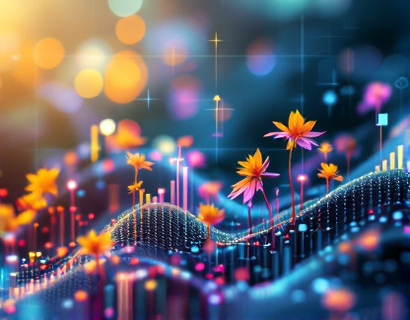Revolutionizing Aquaculture Businesses: The Power of Advanced Software Solutions
In the rapidly evolving world of aquaculture, business owners and managers face numerous challenges that can impact the success and sustainability of their operations. From managing complex supply chains to optimizing resource usage and ensuring compliance with regulatory standards, the demands are multifaceted. Advanced software solutions have emerged as a game-changer, offering a comprehensive suite of tools designed to streamline operations, boost productivity, and enhance overall efficiency. This article delves into the transformative impact of these software solutions, providing insights into how they can revolutionize the aquaculture industry.
Streamlining Operations with Integrated Software Systems
The core advantage of adopting advanced software solutions in aquaculture lies in their ability to integrate various aspects of business operations into a single, cohesive platform. This integration eliminates the need for disparate systems, reducing complexity and improving data accuracy. Key operational areas such as production management, inventory control, and financial tracking are seamlessly connected, allowing for real-time monitoring and decision-making. For instance, a unified system can track fish growth, monitor feed consumption, and adjust feeding schedules automatically based on real-time data, ensuring optimal growth conditions and minimizing waste.
One of the primary benefits of integrated software is the reduction of manual data entry, which is prone to errors and inefficiencies. Automated data collection through sensors and IoT devices ensures that information is accurate and up-to-date. This not only saves time but also reduces the risk of human error, leading to more reliable operations. For example, water quality parameters such as pH, temperature, and oxygen levels can be continuously monitored, triggering alerts when conditions deviate from optimal ranges. This proactive approach helps prevent issues before they escalate, ensuring the health and well-being of the aquatic life.
Enhancing Productivity through Advanced Analytics
Advanced software solutions go beyond basic data management by providing powerful analytics tools that offer deep insights into business performance. These analytics capabilities enable aquaculture business owners and managers to make data-driven decisions, optimizing various aspects of their operations. For instance, predictive analytics can forecast market trends, helping businesses adjust production schedules and inventory levels to meet demand more effectively. By analyzing historical data and current market conditions, these tools provide actionable insights that can lead to significant improvements in productivity and profitability.
Another critical area where analytics shine is in resource optimization. By analyzing consumption patterns and identifying inefficiencies, software can suggest adjustments to feeding regimes, energy usage, and other resource-intensive processes. For example, machine learning algorithms can analyze feed conversion ratios and recommend optimal feed types and quantities, reducing waste and lowering costs. This level of precision not only enhances operational efficiency but also contributes to environmental sustainability by minimizing the ecological footprint of aquaculture operations.
Optimizing Resource Management with Smart Technologies
Resource management is a pivotal aspect of successful aquaculture operations, and advanced software solutions offer innovative tools to optimize the use of water, feed, energy, and other critical resources. Water management, for instance, is crucial in maintaining the health of aquatic organisms and ensuring sustainable operations. Software can monitor and control water circulation systems, filtration, and aeration, ensuring optimal conditions are maintained with minimal resource consumption. Automated alerts and reports help managers stay informed and responsive to any changes, preventing issues before they impact the aquaculture system.
Feed management is another area where software solutions excel. By integrating with feeding equipment, these systems can automate feed dispensing based on real-time data such as fish size, activity levels, and environmental conditions. This precision feeding not only ensures that fish receive the right amount of nutrition but also reduces feed waste, lowering costs and minimizing environmental impact. Additionally, software can track feed inventory levels, generating orders and alerts to prevent stockouts or overstocking, further optimizing resource usage.
Energy management is equally important, especially in large-scale aquaculture operations where energy consumption can be significant. Advanced software can monitor energy usage across various systems, identifying areas of inefficiency and suggesting improvements. For example, by analyzing the energy consumption patterns of pumps, filters, and lighting systems, software can recommend optimal operating schedules and configurations to reduce energy costs. This not only lowers operational expenses but also contributes to a more sustainable business model.
Ensuring Compliance and Regulatory Adherence
Compliance with local, national, and international regulations is a critical concern for aquaculture businesses. Advanced software solutions help ensure that operations remain in line with regulatory requirements, reducing the risk of fines and reputational damage. These systems can be configured to track and manage various compliance aspects, such as environmental permits, health and safety standards, and quality control measures. Automated reporting tools generate the necessary documentation and records, making it easier to demonstrate compliance during inspections or audits.
Moreover, software can provide real-time alerts and notifications when regulatory changes occur, ensuring that businesses stay up-to-date with the latest requirements. This proactive approach helps businesses adapt quickly to new regulations, maintaining smooth operations and avoiding potential disruptions. For instance, if a new environmental regulation is introduced, the software can update the compliance checklist and provide guidance on the necessary steps to achieve compliance, streamlining the process and reducing the burden on staff.
Improving Supply Chain Management
Supply chain management is a complex and critical component of any aquaculture business, involving the procurement of inputs, production, and distribution of outputs. Advanced software solutions offer robust tools to optimize each stage of the supply chain, from sourcing raw materials to delivering finished products to customers. By providing end-to-end visibility, these systems help identify bottlenecks, reduce lead times, and improve overall efficiency.
One key benefit is the ability to track the movement of goods and materials in real-time. This transparency ensures that inventory levels are accurately maintained, reducing the risk of stockouts or excess inventory. For example, software can monitor the delivery of feed and other inputs, generating alerts when shipments are delayed or when stock levels fall below a certain threshold. This level of visibility allows managers to make informed decisions, such as rerouting shipments or adjusting production schedules, to maintain smooth operations.
Additionally, advanced software can integrate with suppliers and customers, facilitating seamless communication and collaboration. Electronic invoicing, purchase order management, and contract tracking are just a few examples of how software can streamline supply chain processes. This not only saves time but also reduces the risk of errors and miscommunications, leading to more reliable and efficient supply chain management.
Enhancing Customer Satisfaction and Market Competitiveness
In a competitive market, customer satisfaction is paramount to the success of any aquaculture business. Advanced software solutions play a crucial role in enhancing customer experience by providing tools that improve product quality, delivery reliability, and customer service. For instance, software can track the entire lifecycle of a product, from hatchery to market, ensuring that quality standards are maintained at every stage. This traceability builds trust with customers, who can verify the origin and quality of the products they purchase.
Moreover, software can help businesses respond quickly to customer inquiries and orders, improving service levels and customer satisfaction. Automated customer relationship management (CRM) tools can manage customer interactions, track orders, and provide personalized communication. This level of service not only enhances the customer experience but also fosters loyalty and repeat business. In a market where customer trust and satisfaction are key differentiators, these tools provide a significant competitive advantage.
Furthermore, advanced software can provide valuable insights into customer preferences and market trends, enabling businesses to tailor their offerings and marketing strategies accordingly. By analyzing sales data, customer feedback, and market analytics, businesses can identify opportunities to expand their product lines, enter new markets, or launch targeted marketing campaigns. This data-driven approach to market strategy ensures that businesses remain agile and responsive to changing market conditions, maintaining their competitive edge.
Conclusion: The Future of Aquaculture Businesses
The integration of advanced software solutions in aquaculture businesses represents a transformative shift towards more efficient, sustainable, and profitable operations. By streamlining operations, enhancing productivity, and optimizing resource management, these tools empower business owners and managers to navigate the complexities of the industry with greater ease and confidence. As the aquaculture sector continues to grow and evolve, the adoption of sophisticated software solutions will be essential for staying ahead of the competition and meeting the demands of a changing market. Embracing these technologies is not just an option but a necessity for success in the modern aquaculture landscape.










































